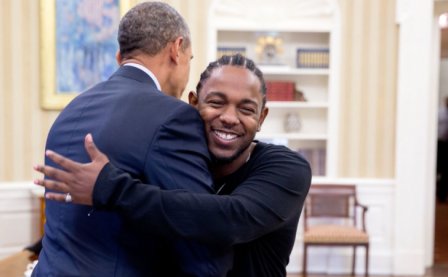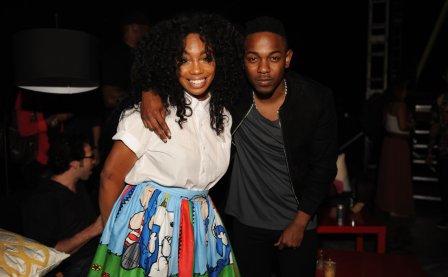For most of his current fans, Kendrick Lamar’s story begins with the creation myth that accompanies Section.80, the most widely heralded hip-hop self-release of yesteryear. The video for its introductory single “HiiiPoWer” opens with a solemn invocation of one Lesane Parish Cookes (“research this name,” it commands), who Lamar claims visited him in an anxious dream, imploring the Compton kid not to let his music die. On “The Heart Pt. 3 (Will You Let It Die),” a song even newer than the recent leak of his new album, good kid, m.A.A.d city, Lamar redirects those expectations upon his audience, audibly tired from all the ones they’ve been placing upon him. Voice halfway gone but defiantly charismatic, the 25-year-old rapper croaks what one can only assume will be his last words for a little while: “Will you let hip-hop die on October 22nd?”
If Lamar’s delusional, he’s not the only one. Living legends Dr. Dre and Snoop Dogg publicly coronated him as the new king of the West Coast; Nas, on the opposite side of the country (and old enough to remember when rap geography mattered), looks to Lamar as the future of the genre in general. Industry rags like Vibe have recently posited all manner of hyperbole, including the possibility that Lamar’s debut is the most important in hip-hop since 1994’s incomparable Illmatic. So it’s no surprise Lamar has come to see himself as the embodiment of a tradition more fragmented and multidirectional than ever, the first week numbers of his major label ablution an acid test for hip-hop’s present-day vitality.
Listening to good kid, m.A.A.d city and all the attendant chatter, it’s tempting to play along. Because Lamar is one of the good ones — certainly worth saving with a few hundred thousand people’s $12.99, as his first “real” album ably deserves. Like Section.80 and the incredible standalone songs from earlier this year, “The Recipe” and “Cartoon & Cereal,” there is plenty here to suggest Lamar has a long career ahead of him. But the album nevertheless falls short of the pedigree his storied elders have set for him, and its status as an all-time classic is far from guaranteed.
For the most part, though, good kid is solid. Throughout these 12 songs (often bi- or tripartite), Lamar reshapes and improves upon enough modern rap tropes to at least partially justify the “unique” and “forward-thinking” mantles that have been placed upon him. “Swimming Pools (Drank),” with its bone-chilling sub-bass and codeine synths, is both a subtle nod to DJ Screw and a lament of the substance-abuse culture that felled him. Lamar ignites Pharrell’s most inspired work in ages on “good kid.” “Sherane a.k.a. Master Splinter’s Daughter” reflects Lamar’s keen instincts in placing a beat, flow, and lyric worthy of a late-album Andre 3000 creeper as the opening track of his own (updated via a pitch-perfect vocal sample that would befit a James Blake or Disclosure production, no less). Lamar even dares use skits and interludes aplenty to craft a deliberately circular and cinematic narrative that unites good kid, a conceptual gesture that succeeds where countless rap records have failed.
Understatement is Lamar’s most reliable virtue throughout: all of the above succeed because they exhibit restraint where most contemporary rappers and producers would be inclined to push things over the line. The same is true of Lamar’s lyrics, which are certainly some of the most eloquent and uniquely expressed in what could tenably be called the mainstream music of today. Enriching his social critiques and hypocritical impulses with a polyvocal array of timbres and registers, Lamar creates a conversation of competing perspectives that engages and thrills in a way that is very much his own. The alien(ated) harmonies of “Bitch, Don’t Kill My Vibe” and anxious, nasal inner voice of “Swimming Pools” fully realize the potential that the rest of good kid only fulfills to varying degrees.
Unfortunately, Lamar’s versatility sometimes gets the best of him. “Backseat Freestyle,” the album’s lone banger, benefits from a demonically raw-throated third verse, but Hit-Boy’s ham beat adrenalizes Lamar beyond his better judgment from the onset (debasing MLK Jr.’s most resonant words with a particularly stupid dick joke, for one). Perhaps worse for good kid’s legacy is the closing hydraulics of “Compton,” a perfectly competent tribute to Chronic-era G-funk (Dr. Dre himself pretending he still likes to rap or produce behind a Just Blaze beat), which for that very reason falls flat as a conclusion to a truly modern rap statement. Lamar himself announces the title of “King Kendrick” at the time we’re least compelled to listen, the old doctor logs another verse about his lucrative brand of luxury headphones, and the whole affair fizzles to a bizarre end with a knowingly cheesy vocoder solo. good kid is sure to have hip-hop heads arguing more fervently than they have in a long time, and rap today is better for it — but few enduring classics have ever ended with what feels like a bonus track.
More about: Kendrick Lamar




